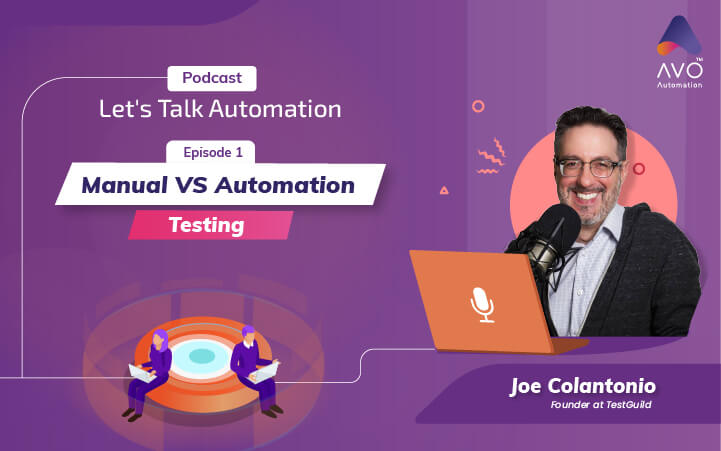Ep 1 of Let’s talk automation with Joe Colantonio
With software becoming a prominent part of our lives, ensuring its top-quality is the onus of today’s organizations. Software testing empowers teams to deliver this promise with confidence. In this episode of Avo Automation’s podcast, ‘Let’s talk automation,’ we will demystify the differences between manual and automated testing. And to help us demystify them, we are joined by Joe Colantonio – a software test automation guru and the founder of TestGuild.
Listen to this podcast here.
Let’s dive in.
To begin with, the primary difference between manual and automated testing is that manual testing, like the name suggests, is done by manually executing the test cases, and automated testing uses software to run the testing for you. With automation, you could choose to automate either a part or whole of the process.
The evolution
The evolution of test automation products is nothing short of phenomenal. Test automation products have come a long way from WinRunner in the ’90s, which was more of a record and playback tool, to the Selenium revolution in the 2000s. With various products leveraging AI and ML in the market today, test automation has become the primary enabler of quality software delivery while undergoing digital transformation across the enterprise.
As a part of this transformation, companies are rapidly transitioning to agile software delivery. But testing being the longest pole in the tent, eats up most of the time in a 2-week sprint cycle – which necessitates adopting test automation for teams to achieve true agility. And by automation, we mean test automation spanning diverse levels of infrastructure, APIs, UI, and more across the entire delivery pipeline.
This brings us to the most debated question – should we automate everything? With test automation solutions promising faster, higher-quality delivery and increased team productivity, automating everything might seem like a stairway to increased ROI. Automating everything doesn’t give the highest returns. Teams need to follow a strategic approach to testing where they ‘automate the right things at the right time to leverage automation correctly.’ And this is where the role of quality specialists becomes indispensable.
The role of quality specialists
Gone are the days when testers would come into the picture, typically at the tail end of the development process. Testers in today’s age are not mere testers; they are ‘quality specialists,’ who play a far more strategic role than pushing buttons and following hard-coded test scripts. They ensure imbibing ‘quality’ right along the delivery pipeline, from defining the requirements through deployment. This assures a high-quality product within the stated timelines, leading to organizations achieving true business agility.
And that’s why, if you believe in the myth that automation will take over manual jobs, you would simply be restating a myth – because manual testing is here to stay and for good. A balanced mix of automated and manual testing is the secret sauce to the highest automation ROI, and your quality specialists know its recipe.
Building a culture of automation
Even with these facts in place, most organizations still think of test automation as a cost center and not an innovation center. This is mainly because of the uncertainty that experimenting too much with automation would break things in production, leading to business outages.
Considering automation as more of a culture than a task helps improve this mindset. It all starts with a goal and a solid automation plan to ensure success in the long term. And investing in the right solution that accommodates your future requirements will sustain this culture of automation.
Watch this podcast and get in-depth insights here.

